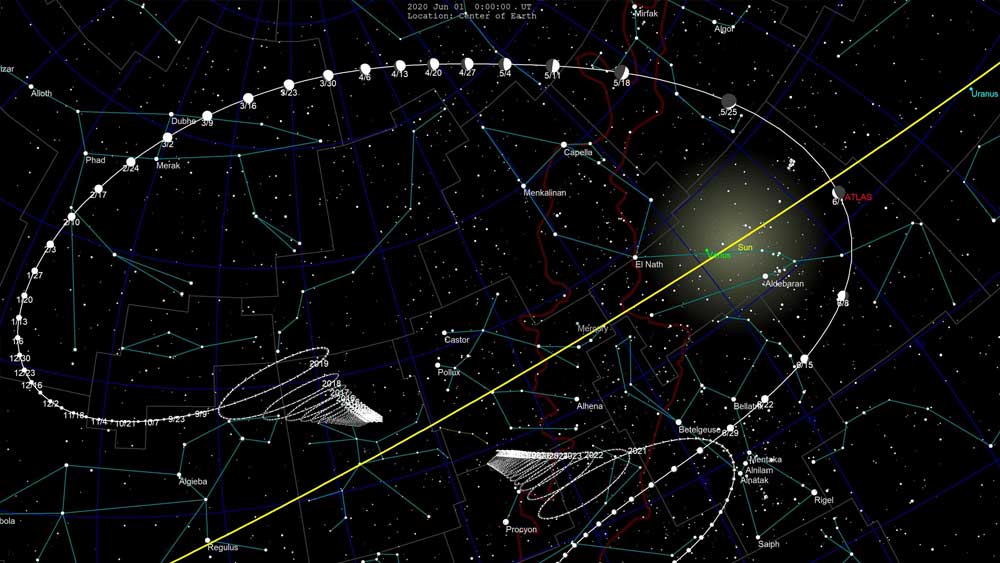For northern-hemisphere families in isolation due to the coronavirus pandemic, a recently discovered comet may provide some needed diversion.1 This comet is dubbed ATLAS after the Hawaiian organization that discovered it: the Asteroid Terrestrial-Impact Last Alert system. The comet is barely bright enough to be seen with binoculars under dark sky conditions.2
This comet is somewhat unusual for a number of reasons. First, this comet is greenish in color. Second, it has dramatically increased in brightness (by a factor of 4,000) in just one month. Astronomers expect it to reach its maximum brightness at the end of May. If its brightening trend continues and the comet remains intact, it could become brighter than the planet Venus as seen from Earth.2
A star map showing the comet’s position every seven days has been published online and can be accessed here.2 Should the comet become bright enough, plotting its path on a sky chart would make a good do-at-home science activity for families isolated due to the coronavirus. A printable PDF sky map can be found at the website Heavens Above.3 Even for those not able to go outside, an Italian astronomer has posted observations of the comet online, with the specific goal of helping those who are self-quarantined.1
As any comet gets closer to the sun, ices in the comet nucleus vaporize, forming a fuzzy cloud around the comet, and sometimes the long beautiful tails, for which comets are so well-known.4 For this reason, a comet loses some of its mass during each orbit. Eventually no more ices remain, and the comet is no longer visible. In fact, comets often disintegrate as they approach the sun. Secular astronomers think comet nuclei are “leftovers” from the formation of our solar system 4.6 billion years ago. However, most comets can only last thousands of years, not billions or even millions.
Secular astronomers are, of course, aware of this, but they claim that reservoirs of potential comet nuclei can resupply the solar system with new comets to replace those that have been destroyed. Comets with long orbital periods, like Comet ATLAS, are thought to originate from an enormous “cloud” of comet nuclei called the Oort Cloud. Comets with shorter orbital periods are thought to originate from belts of bodies, called the Kuiper Belt and the Scattered Disk, that lie beyond Neptune’s orbit.
However, there are problems with these supposed comet reservoirs. For instance, while some astronomers think that short-period comets with orbits similar to Halley’s Comet originate from the Scattered Disk, other astronomers have pointed out that the Scattered Disk does not have nearly enough material to serve as a reservoir for Halley-type comets. So they suggested that perhaps Halley-type comets originate in the Oort Cloud.5 But there’s no direct evidence that the Oort Cloud even exists, as acknowledged even by the well-known secular astronomer Carl Sagan!6
Comet ATLAS may provide a much-needed diversion for home-bound families during the coronavirus pandemic. But it is also one of many reminders7-10 that our solar system is young.
References
1. Irizarry, E. How to see bright Comet ATLAS. EarthSky. Posted on earthsky.org March 22, 2020, accessed March 23, 2020.
2. Yirka, B. Comet ATLAS may put on quite a show. Phys.org. Posted on phys.org March 23, 2020, accessed March 23, 2020.
3. Interactive sky chart. Heavens Above. Posted on heavens-above.com, accessed March 25, 2020.
4. In fact, the word comet derives from a Greek word meaning “wearing long hair,” a reference to comets’ hair-like tails.
5. Wang, J.-H. and R. Brasser. 2014. An Oort Cloud origin of the Halley-type comets. Astronomy & Astrophysics. 563, A122.
6. Druyan, A. and C. Sagan. 1985. Comet. New York: Random House, 398.
7. Hebert, J. 2018. Our Young Solar System. Acts & Facts. 47 (9).
8. Hebert, J. 2019. Moon is Unexpectedly Still Cooling and Shrinking. Creation Science Update. Posted on ICR.org June 6, 2019, accessed March 25, 2020.
9. Thomas, B. Pluto’s Craterless Plains Look Young. Creation Science Update. Posted on ICR.org November 23, 2015, accessed March 25, 2020.
10. Hebert, J. Youthful Solar System Bodies Puzzle Evolutionary Scientists. Creation Science Update. Posted on ICR.org February 13, 2013, accessed March 25, 2020.
Stage image: Comet's trajectory in the sky with 7-day markers.
Stage image credit: Tomruen/CC BY-SA 4.0/Wikimedia Commons. Used in accordance with federal copyright (fair use doctrine) law. Usage by ICR does not imply endorsement of copyright holders.
*Dr. Jake Hebert is Research Associate at the Institute for Creation Research and earned his Ph.D. in physics from the University of Texas at Dallas.

Comet ATLAS: Nighttime Diversion for Isolated Families
The Latest
Florida Fossil Shows Porcupines Have Always Been Porcupines
The porcupine is an animal (rodent) that one does not soon forget. It is armed with formidable quills that deter even the hungriest predators. What...
Webb Telescope Discovers Another Record-Breaking Galaxy
Astronomers using the James Webb Space Telescope have recently confirmed that two galaxies are extremely distant, with one becoming the new record holder...
CREATION PODCAST
The Power of Film & Video: Reaching All Ages with Truth | The...
Is there a place for the use of film and video within Christianity? If so, how can we leverage this powerful tool to reach viewers of all ages...
Scaly Skin on a Feathered Dinosaur?
Fossil experts from University College Cork in Ireland took stunning images of Psittacosaurus skin. The dinosaurs’ belly shows patches of skin...
T. rex Not as Smart as Thought
Have movies and most conventional paleontologists got it all wrong? T. rex and other theropod dinosaurs (the meat-eaters) are often portrayed as intelligent...
June 2024 ICR Wallpaper
"For by grace you have been saved through faith, and that not of yourselves; it is the gift of God." (Ephesians 2:8 NKJV)
ICR June...
A “Just-so” Story About Ancient Genes
An evolutionary website recently published “a groundbreaking study” that supposedly identifies a basic, uncomplicated, “simple”...
CREATION PODCAST
Dinosaurs with Bird Brains??? | The Creation Podcast: Episode...
Evolutionists claim that birds are descended from dinosaurs. A feature that is often cited as linking these two types of creatures is the brain....
CREATION.LIVE PODCAST
From Ruins to Revelation: Truths Revealed Through Biblical Archaeology...
The Bible is full of people and places that are seemingly lost to time, but through the field of archaeology, new finds are shedding light on the incredible...
Bergmann’s Rule Falsely Refuted
A recent study of dinosaur sizes claims to break Bergmann’s rule.1 Bergmann’s rule was named after biologist Carl Bergmann, who...



























